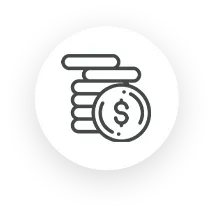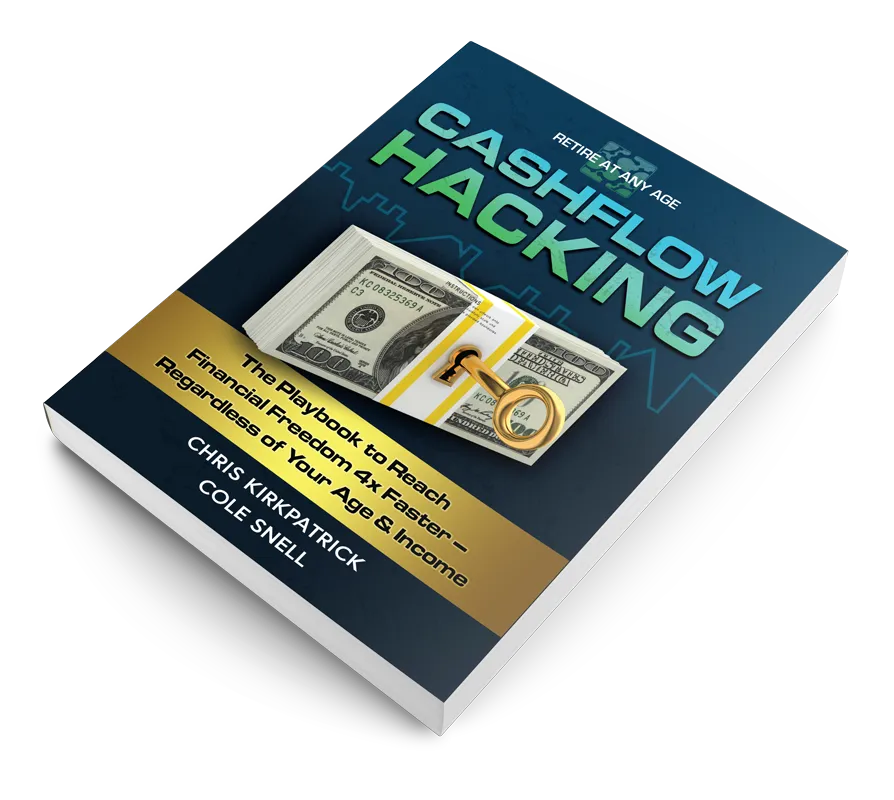
Simplifying Financial Confusion
LEARN CASH FLOW HACKING TO REACH FINANCIAL FREEDOM
Used by 90% of millionaires to reach their financial goals 4x faster

Achieve Financial Freedom Through Cash Flow Hacking

Increase Your Lifestyle While You Build Your Wealth

Position Yourself to Thrive in Market Downturn
YOU SHOULD NOT FEEL OUT OF CONTROL ABOUT YOUR FINANCIAL STRATEGY

Have easy access to your money in case of emergencies and opportunities

Use the investment strategy 90% of millionaires use

You deserve a clear plan to consistently grow your money and avoid market uncertainty

Have a guide and advisor that has your best interest in mind

Do not overpay in taxes

Stop guessing at the best vehicles to protect and grow your money

Top Financial Concerns for People 55+ | How Whole Life Can Help

LIFE180
Top Financial Concerns for People 55+ | How Whole Life Can Help
This article is a written adaptation of the video that resides on the LIFE180 YouTube channel.
As you approach 55 years old, it's crucial to reassess your relationship with money. The strategies you've employed to manage your finances must undergo significant revisions as retirement draws nearer. Your financial priorities undergo a profound transformation during this period.
In this article, we'll explore how whole life insurance can alleviate various financial worries for individuals aged 55 and older. Now, we'll address the top concern: running out of money. Let's dive in.
Concern 1 - Running Out of Money
As individuals near retirement and step into their retirement years, a pressing concern that looms over them is the fear of depleting their financial resources. Surveys reveal a startling fact: about 70% of people admit to harboring a greater apprehension of running out of money than they do of facing mortality itself. This statistic starkly illustrates the deep-seated worry many harbor regarding financial stability during their later stages of life.
Now, the foremost challenge they encounter is what's commonly referred to as longevity risk.
Risk 1 - Longevity Risk
Now, you're concerned about running out of money, but there are different risks that increase our chances of running out of money. What we have to do with our money to galvanize and insulate ourselves from those risks is to understand the various financial tools and products available to us.
Longevity risk acts as an amplifier of risk because it magnifies all the other risks we face. The longer we live, the more likely we are to encounter problems such as economic downturns, recessions, and market fluctuations during our retirement years.
Consider this: if you live until you're 95 or 100 years old, meaning you have a long lifespan, you could be in retirement for 35 years or more. That's a substantial portion of your life where you must ensure your finances last, potentially amidst challenging economic conditions. So how are you going to weather that storm? This is where the concept of sequence of return risk comes into play.
Risk 2 - Sequence of Return Risk
If you retire with what you believe is sufficient funds and a well-modeled plan, imagine retiring, for instance, in 2007. You might have felt financially secure, only to be blindsided by the events of 2008. Suddenly, due to conservative investments in the S&P 500, 40% of your portfolio evaporates overnight.
Suddenly, upon entering the industry in 2009, I encountered countless individuals facing a common predicament. It's difficult to express just how many people I met who had to re-enter the workforce after attempting retirement. Their struggle stemmed from a lack of comprehension about managing their finances effectively, particularly in mitigating the sequence of return risk. This failure to grasp essential financial concepts had a profound and detrimental impact on their lives.
Risk 3 - Monte Carlo Simulation
Hence, the concept of Monte Carlo simulations becomes pivotal. Financial planners rely on these simulations to assess factors such as how much money you may require and the probability of running out of funds during retirement, based on assumed rates of return.
There's a concept known as the 4% rule, which is often relied upon by many individuals. It suggests that for a lump sum of money, let's say $2 million, you could safely withdraw 4% of that amount annually as income. This rule posits that with this approach, you have a high probability of sustaining your finances throughout your lifetime without depleting your funds.
Thus, with $2 million, according to the 4% rule, you'd have an annual income of $80,000. However, for many individuals capable of saving such a substantial sum, this amount may not suffice to maintain their desired standard of living. This discrepancy poses a significant challenge for them.
How Whole Life Insurance Helps Mitigate Financial Risks in Retirement
Now, where whole life insurance becomes crucial is in its ability to mitigate many of these risks. It's important to grasp that it can offer a decent rate of return, guarantees, and liquidity. Especially if you start early, such as at 55, it can serve as a volatility buffer, providing stability as you build up your financial resources.
So, particularly for individuals aged 55 and older, speaking directly to the demographic this article addresses, it's essential to recognize that whole life insurance should not be viewed as your sole asset.
Many online sources currently advocate for utilizing indexed universal life or whole life insurance as the primary source of tax-free income in retirement. However, this notion couldn't be further from reality.
Firstly, in my opinion, it's not a sound strategy regardless of when you start, even if you begin at a younger age, like 30. Secondly, if you commence at 55, you won't have adequate time for these policies to accumulate enough value to serve as your primary income source, even if one were to endorse that idea, which I do not.
For me, it means positioning yourself in a situation where you allocate a portion of your funds to a whole life insurance account. This functions as a volatility buffer, supporting your other assets.
Whole Life Isn't An Investment - It Simply Makes Your Investments Better
In some of my other content, I often liken whole life insurance to the BASF of the financial industry. It doesn't directly make the investments you undertake; rather, it enhances the investments you make. It's akin to the BASF slogan from the 90s: "We don't make the products you buy, we make the products you buy better."
With whole life insurance, it's not about being the primary investment; rather, it serves to fortify your investment portfolio. Here's what I mean: it can assist in mitigating risks such as the sequence of return risk. By doing so, it not only reduces the impact of longevity risk but also extends the longevity of your funds, making your financial resources more likely to sustain you over time.
So, imagine you had a pool of money, let's say a million dollars, and you retired in 2007. At that time, you thought, "I need $40,000 annually from this account," and you felt confident about it. However, 2008 came along, adhering to the 4% rule, and suddenly things took a turn for the worse.
Now, in 2008, the unforeseen occurred, and that million-dollar nest egg plummeted, let's say by 35%, a middle-ground estimation between some experts' opinions of 40% and others of 30%. So, you're left with $650,000. Here lies the issue: despite the economic downturn, your need for $40,000 of income per year remains unchanged.
Now, the question arises: what percentage of $650,000 is $40,000? It's almost 6.2%, which represents a significant increase compared to the 4% rule. If you continue withdrawing and distributing $40,000 from your diminished $650,000 as you were before, the likelihood of exhausting your funds becomes alarmingly high.
If you have this money, it's essential to ensure you have enough in a side fund. This is where whole life insurance can be invaluable. It functions as a side fund that grows on a guaranteed basis, providing tax-free access that you can utilize as a volatility buffer.
Whole Life Insurance As A Volatility Buffer
By adopting this approach, as exemplified by the market recovery of 2008, you steer clear of the damaging effects of prematurely liquidating underperforming assets. Instead of leaning solely on whole life insurance as your primary retirement income source, it serves as a vital resource during portfolio downturns. With funds allocated to your whole life insurance policy, you can access the necessary income multiple times throughout retirement, effectively navigating adverse market conditions.
This strategy not only mitigates longevity risk and sequence of return risk but also enhances the accuracy and effectiveness of Monte Carlo simulations. It provides leverage for you across every phase of life, underscoring the value of a properly designed whole life insurance policy.
When discussing individuals aged 55 and older, the best time to start is undoubtedly as soon as possible. By initiating the policy at age 55, there's ample time for it to grow, build liquidity, and navigate through the fee stage. As you age, you can contribute more cash, and the Modified Endowment Contract (MEC) rules tend to work in your favor. The key is to begin the process at the earliest opportunity, allowing us to accumulate capital in the policy to serve as a volatility buffer and mitigate various risks.
Ultimately, it's essential to start as soon as possible, particularly for those aged 55 and older. Beginning the policy at this age allows for adequate time for growth, liquidity building, and fee stage navigation.
Additionally, with age comes the ability to contribute more cash, with MEC rules favoring older individuals. Initiating the process early enables the accumulation of capital in the policy, serving as a volatility buffer and effectively mitigating risks.
If you found value in this article, don't hesitate to follow my content and share it with others who may benefit from it. Your support and sharing can help reach more persons and provide them with valuable insights.
Until next time, have a blessed, inspirational day.
HOW TO START TAKING CONTROL OF YOUR FINANCES BY MAXIMIZING YOUR CASH FLOW AND PROTECTING YOUR ASSETS

1. Schedule Your Free Clarity Call

2. Create a Free Customized Plan

3. Get Guide to Financial Success
GET YOUR FREE COPY TO STOP USING OUTDATED RETIREMENT STRATEGIES
Cash Flow Hacking teaches you to:
Protect Your Investments
Thrive in bad markets
Reach financial freedom faster

ARE YOU LOOKING FOR:

Cash Flow Hacking teaches you to:
Security to protect your money
Increased cash flow and lifestyle
Inflation protection
Financial certainty in all economic environments
A reduction in taxes
Safe and fast access to your money with no penalties
WHO IS THIS PROGRAM FOR?

People looking for an alternative
Are you looking for alternatives to Wall Street’s “buy and hold” strategy that takes 40 years with uncertain results? Our Cash Flow Hacking strategies provide you the building blocks to get started on the right foot

Passionate Entrepreneurs
Are you looking for a financial strategy that will take your best assets (you and your businesses) and multiply their potential? Our Cash Flow hacking strategies will teach you how to invest for the future without sacrificing building your business

Real Estate
Investors
Are you a real estate investor who is burned out from being a landlord or playing the fix-and-flip game? Our Cash Flow Hacking strategies will provide you with the system to create predictable wealth AND give you the freedom you are looking for.
YOU DESERVE PEACE OF MIND AND A PLAN THAT WILL PROTECT YOUR FAMILY AND GROW YOUR WEALTH
Today you need to be more savvy than ever if you try to go at it alone.
Losing money to inflation, taxes, and just poor investment strategies is leaving you frustrated, feeling out of control and not knowing where to turn. To add to the problem, the market is flooded with advisors who have outdated advice that does not place your best interests first, but instead focuses on charging you a fee that creates guaranteed cash flow for them.
NOT YOU
We believe this is wrong and that your security and best interests should be placed first. We believe you should be in a position where you control your money, your money doesn't control you. We understand because we talk with hardworking people everyday that are losing money in the markets based on old information and feel like they are guessing at the best course of action.
We created the Cash Flow Hacking plan to help you have security and control of your money to take advantage of life's opportunities because you deserve peace of mind with your wealth. The old way of planning for retirement of… Go to school Get a job & save as much as you can in your 401k and mutual funds...is broken.
You have been lied to. Think about it, where else in life does someone tell you that the most certain way to achieve your desired result is to take on more risk? The math just doesn't work, and the results are showing in our country and world. Did you know that 90% of millionaires in the United States have 1 asset in common?
Hint: it's not stocks or mutual funds (and no...it's not crypto) How much sense does it make for you to work hard, save money, reduce your current lifestyle (because that's what you are doing when you save for the future - taking money you could use on lifestyle today and delaying gratification to a future unknown time), and hope that whatever you are doing will work three to four decades from now? If you're thinking, "not much sense at all…", you are in the right place.
With over 50 years of experience on our team, we have worked with thousands of individuals and families to achieve financial freedom faster and with more predictability by helping them invest for Cash Flow.
How does the Cash Flow Hacking Plan work? 1. Take the Cash Flow Hacking Challenge 2. Complete the LIFE180 X-Ray and determine what your Freedom Number is 3. Work with a Cash Flow Hacking expert to provide you a customized plan
The customized Cash Flow Hacking plan will give you clarity on where you are now, where you want to go (and in what time frame), and what you need to do to get there predictably.
We value and commit to you: We believe you deserve the best financial education and guidance We believe financial decisions should not be rushed but be well thought out with a plan We believe you should be in control of your money We believe we earn your trust through time, education, and proper due diligence Without a proper plan and guidance, your money can be lost to taxes, inflation, and bad investments You deserve more with the most up-to-date strategies to mitigate your risk, control your money, and earn stable returns regardless of the market Schedule a call here to attain your LIFE180 Financial X-Ray now or get started with the Cash Flow Hacking Challenge for free.
I am interested in...